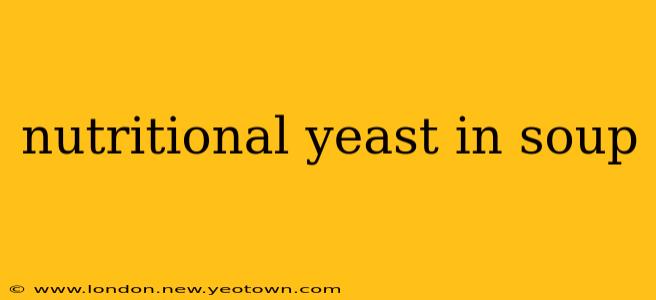Nutritional yeast. Just the name conjures up images of health food stores and perhaps a slightly…earthy taste. But for those in the know, nutritional yeast is a culinary chameleon, capable of transforming even the simplest soup into a savory masterpiece. It's more than just a health food; it's a flavor enhancer, a cheesy substitute, and a nutritional powerhouse, all rolled into one golden-yellow powder. This isn't your grandma's chicken noodle soup; this is a journey into the world of umami-rich, nutrient-packed, and undeniably delicious soups, all thanks to the magic of nutritional yeast.
My journey with nutritional yeast began unexpectedly. I was trying to create a vegan alternative to a creamy tomato soup I loved, and a friend suggested sprinkling in some nutritional yeast at the end. The result? A revelation. The soup transformed from a simple, albeit tasty, tomato base into a rich, cheesy, and unbelievably satisfying bowl of goodness. That’s when I realised the true potential of this often-overlooked ingredient.
What is Nutritional Yeast, Anyway?
Before we dive into the delicious possibilities, let's get the basics down. Nutritional yeast is a deactivated yeast, meaning it's not active like the yeast used in baking. It's grown on molasses, then harvested, washed, and dried. This process results in a completely safe and inactive powder, packed with nutrients and possessing a unique, cheesy, nutty flavor.
How Does Nutritional Yeast Enhance Soup?
The beauty of nutritional yeast lies in its versatility. Its nutty, cheesy flavor profile is a perfect complement to numerous soup bases, adding depth and richness that other ingredients often struggle to replicate. It’s not just about taste; nutritional yeast also brings a boost of essential nutrients to your bowl, including protein, B vitamins, and fiber.
Does nutritional yeast add a cheesy flavor to soup?
Yes! This is perhaps the most celebrated aspect of using nutritional yeast in soup. Its savory, umami flavor profile provides a surprisingly convincing cheesy note, making it a popular ingredient for vegan and vegetarian cooks seeking to replicate the creamy texture and taste of traditional cheese-based soups. Think creamy tomato soup, broccoli cheddar soup, or even a mac and cheese soup, all made vegan-friendly with the help of nutritional yeast.
How much nutritional yeast should I use in soup?
There's no one-size-fits-all answer to this question. The amount of nutritional yeast you add will depend on the type of soup you're making, your personal preference, and the desired intensity of the cheesy flavor. Start with a small amount (about 1-2 tablespoons per quart of soup) and taste as you go. You can always add more, but you can't take it away!
When should I add nutritional yeast to soup?
Generally, it's best to add nutritional yeast towards the end of the cooking process. Adding it too early could result in a slightly bitter taste. Stir it in during the last few minutes of simmering, or even sprinkle it on top as a garnish right before serving. This allows the flavor to meld with the other ingredients without becoming overpowering.
What types of soup is nutritional yeast best for?
The possibilities are endless! Nutritional yeast pairs beautifully with creamy tomato soups, vegetable soups, lentil soups, mushroom soups, and even hearty broths. Its umami notes complement both light and robust flavor profiles. Consider it as an ingredient that adds a final touch of magic and depth to any soup that needs an extra kick.
Is nutritional yeast good for you?
Absolutely! Nutritional yeast is a complete protein, meaning it contains all nine essential amino acids. It's also a good source of B vitamins, fiber, and other essential minerals. It's a fantastic addition to your diet if you're looking to boost your nutritional intake in a delicious and convenient way.
In conclusion, nutritional yeast isn't just another ingredient; it's a secret weapon in the soup-making arsenal. Its ability to transform ordinary soups into extraordinary culinary experiences, coupled with its impressive nutritional profile, makes it a must-have for any home cook, regardless of dietary preferences. So next time you're looking to elevate your soup game, remember the golden powder that adds so much more than just flavor—it adds a touch of magic.

